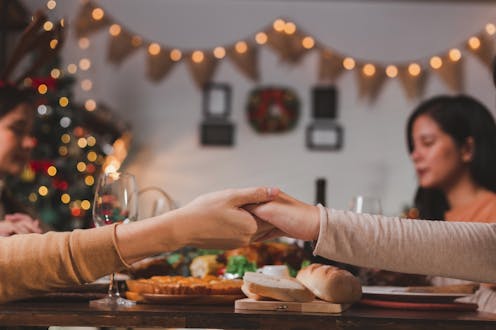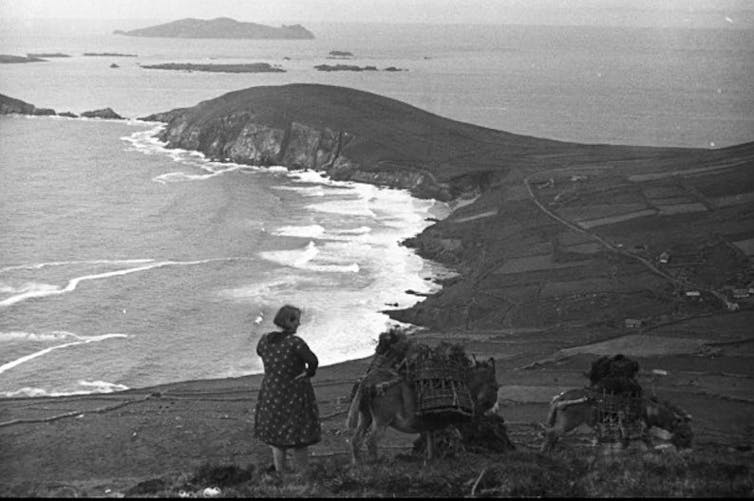
Growing up in west Kerry, Christmas was (and still is) not officially over until after Nollaig na mBan (Women’s Christmas) on January 6 – candles are lit in windows and decorations are not taken down until the next day.
I’ve celebrated this since I was a child. My grandmother loved Nollaig na mBan, when my Dad would collect her around lunchtime and bring her to visit with her sister in Dún Chaoin, a village in west County Kerry. They would both dress in their Sunday best, my grandmother wearing the colourful beaded necklace she saved for special occasions.
Like women all over Ireland on January 6, the two sisters would have a catch up, eat some cake and maybe even have a glass of punch before deciding what other calls they wanted to make to their friends that day. My dad was their chauffeur because Nollaig na mBan was traditionally a “day off” for women after organising and executing a busy Christmas holiday for their families.
For my grandmother’s generation in West Kerry, it was a day to catch up and socialise with other local women who had worked hard over Christmas. After currant cake and chats in various homes, my dad would drive them to one of the local pubs to meet other friends and where there might be some music. The ladies would continue their catch-ups there over sherries and hot brandies – a lovely way to finish up their busy Christmas season.
Celebrating Nollaig na mBan around Ireland
The tradition of Nollaig na mBan has been celebrated for generations in West Kerry. Elsewhere in counties Kerry and Cork, as well as other Gaeltacht (Irish-speaking) areas it was also common, but in many other communities around Ireland it was not a tradition at all.
In these places, January 6 is more likely known as “Little Christmas” (because would finish the leftovers of larger Christmas feasts) or the Feast of the Epiphany, the last of the 12 Days of Christmas. Oíche na dTrí Rithe (the Night of the Three Kings) marks the visit of the three wise men to the baby Jesus. People place the three kings in their Christmas nativity cribs, and often light three candles in their windows to mark the common lore around the kings turning water into wine on the January 6. As Irish folklorist Kevin Danaher wrote:
Oíche na dTrí Rithe,
Sea deintear fíon den uisce(The Night of the Three Kings,
The water turns to wine)
It’s only been in recent years that I’ve realised how lucky I was to have grown up with such a strong tradition of celebrating women on this day. And from what was traditionally a time when women could visit each other for a chat over the food and drink of their choice, the day has since become a chance to go out, support and celebrate each other.
In 1970, Danaher wrote of Nollaig na mBan: “Christmas Day was marked by beef and whiskey, men’s fare, while on Little Christmas Day the dainties preferred by women – cake, tea and wine, were more in evidence”.
While during the Christmas season foods were heavier, by January 6 people were generally finishing off the bits and pieces of leftover food. Certainly, “dainties” and currant cakes were the norm for my grandmother’s gatherings. And the saying: “Nollaig na mBan, Nollaig gan mhaith” (Women’s Christmas, no good Christmas) was sometimes bandied around by men as a bit of a jibe that alludes to the “lesser” foods typically eaten on the day.
When we read about the origins of the tradition today, many articles focus on the idea that women took the day off from their usual housework and chores. But during and since my granny’s time, many women still undertook the usual duties in the morning, putting aside time to rest and socialise from lunchtime onwards.

Modern-day Nollaig na mBan traditions
In the past ten years or so, Nollaig na mBan has risen in popularity all over Ireland, with city pubs and restaurants from Belfast to Cork advertising special menus and events. For the second year, a Nollaig na mBan festival is celebrating women in north County Dublin.
Increased awareness of this tradition has spread via social media and other coverage, undoubtedly helping to stoke this enthusiasm. Online discussion around Nollaig na mBan often centres on celebrating historical figures or creatives, alongside pictures women post of themselves with their female family members and friends.
Today in west Kerry, Nollaig na mBan is celebrated with great fervour and in many ways is very similar to my granny’s time, although we tend to gather in local hotels, restaurants and pubs for our catch-ups. Grannies, mums, sisters and daughters often hold brunch and lunchtime meet-ups, while groups of friends and work colleagues might celebrate at night.
January 6 is still a time to remember and celebrate women in Ireland, but it’s become much more similar to the way International Women’s Day (on March 8) is celebrated: it’s a day to read and share work by female writers, poets and musicians, a day to wear jewellery and clothes by Ireland’s many female designers, whether it’s a Margaret O'Connor neckheadpiece or an Emma Manley leather skirt.
Nollaig na mBan is a day to remember how far women in Ireland have come since the latew 1970s before which bans against contraception and married women working limited our freedom. But it also reminds us how far women have yet to go in gaining true equality in business and society.
agranville@ucc.ie previously received funding but not currently from Culture Ireland, Arts Council of Ireland, Ealaín na Gaeltachta, Kerry County Council. She is affiliated with the Board of the Arts Council of Ireland and works at the Folklore Department, University College Cork.
This article was originally published on The Conversation. Read the original article.







